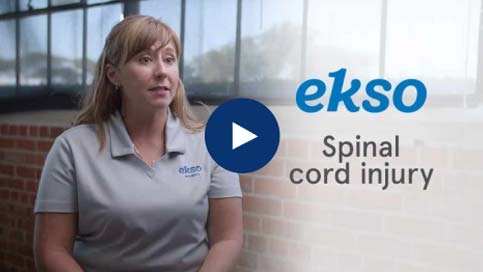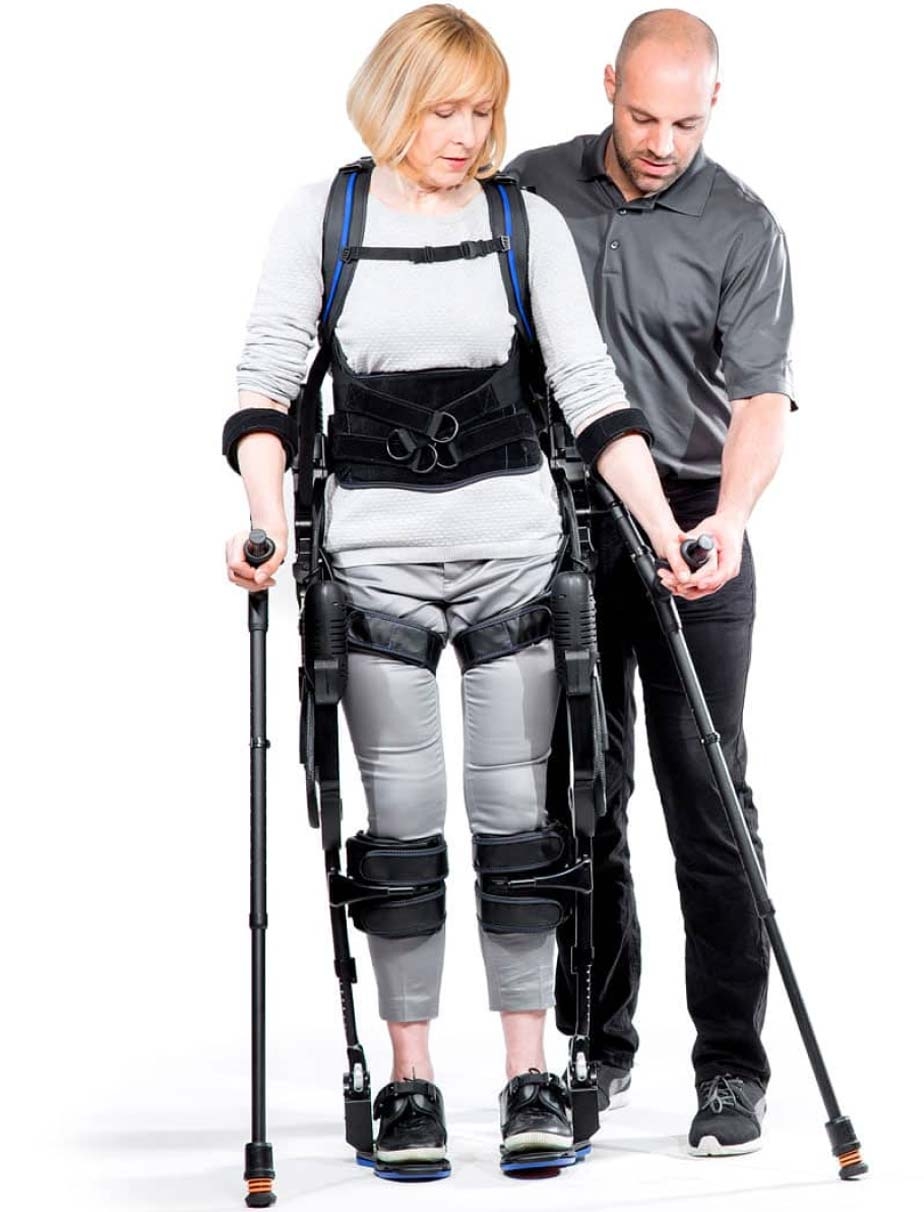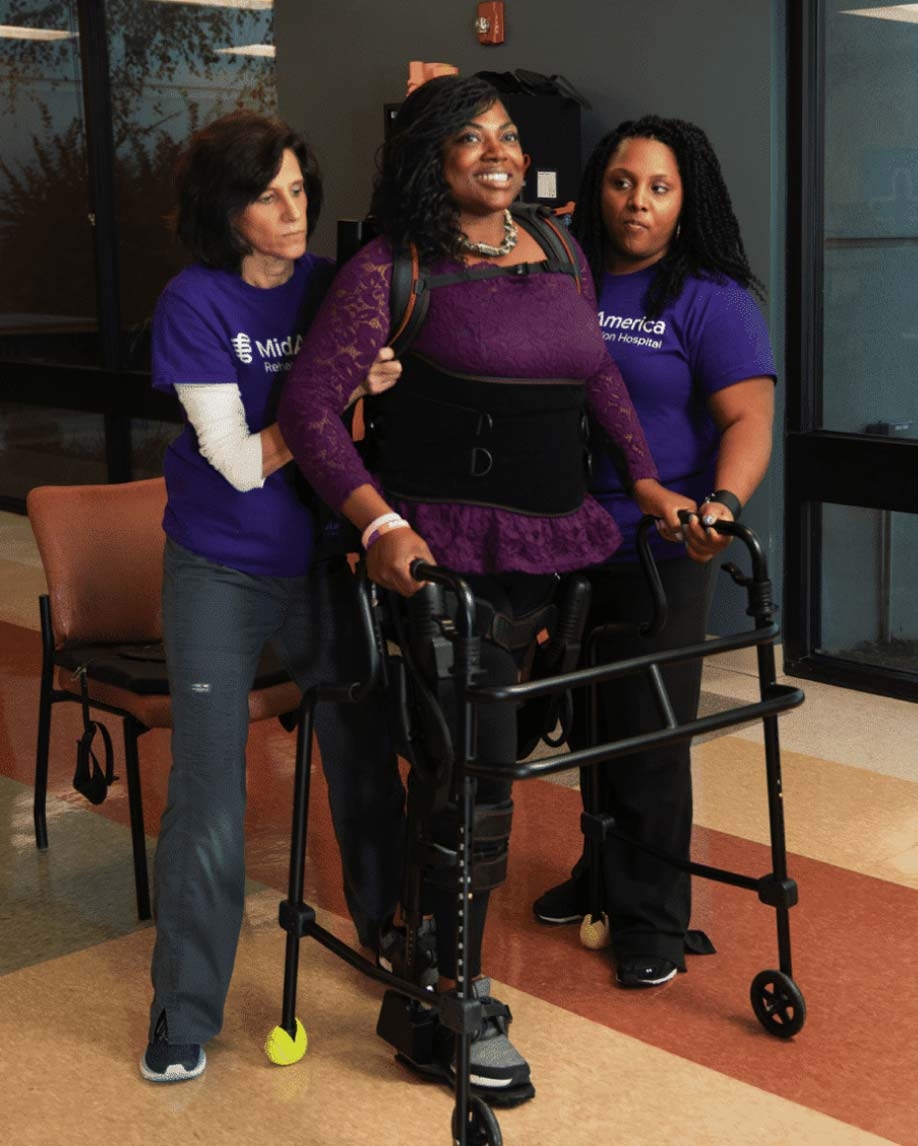Spinal cord injury
Ekso Bionics manufactures robotic exoskeletons that support patients recovering from and living with spinal cord injuries (SCI) and allows them to work on regaining balance, coordination, and strength. Ekso offers exoskeletons for individuals with SCI across the continuum of care, from hospital to home.

Exoskeletons designed to support
patients and enhance recovery
Our lower-extremity, wearable robotic exoskeletons are designed for individuals who have lost mobility or function. These devices help patients recover more completely and rehabilitate from spinal cord injury by leveraging neural plasticity and providing protective support. Neural plasticity is the ability of the brain and spinal cord to rewire themselves, allowing functions that were lost due to an injury to be relearned.

What is SCI?
SCI includes damage to any part of the spinal cord or the nerves at the end of the spinal canal. The injury results in a lack of neural communication between the brain and the body at the location of the injury. SCI can be categorized as a complete or incomplete injury based on how much of the spinal cord was damaged, leading to varying amounts of motor and/or sensory loss. SCI can be caused by several factors including motor vehicle accidents, falls, and tumors. The majority of individuals who have experienced SCI were injured in a traumatic way.
Patients with SCI exhibit a range of potential symptoms including:
- Weakness or paralysis in upper and/or lower extremities
- Pain in the neck, back, or head
- Urinary or bowel urgency, retention, or incontinence
- Spasticity
- Muscle atrophy
- Impaired cardiovascular responses
Based on the individual’s symptoms, level, and severity of injury, they can experience deficits in their ability to independently complete activities of daily living (ADLs) as well as see an impact to their quality of life. Not only does a spinal cord injury limit mobility, the resulting lack of physical activity can increase the risk for cardiovascular disease, respiratory issues, and bone fractures.

Exoskeletons role in rehabilitation
Patients with spinal cord injuries begin rehabilitation very soon after their injury, and this therapy continues throughout their lifetime. During rehabilitation, patients are working on functional skills such as transferring, walking, and getting out of bed.
Exoskeletons are utilized during rehabilitation by supporting upright posture and allowing patients to get into a standing position soon after their injury. This weight bearing on their legs helps reduce the risk of future fractures and acclimates their cardiovascular system to upright positions. Research on exoskeletons show that patients with SCI can experience gains in function, strength, endurance, and sensation after using an exoskeleton as part of their rehabilitation.
In combination with supporting upright standing positions, patients can also use exoskeletons to promote walking activities. The exoskeleton can provide full assistance for patients with more significant weakness or complete paralysis. For patients who have emerging strength, the exoskeleton can adapt to provide less assistance as the patient gets stronger. This allows them to work their muscles without risk of injury while progressing through their recovery. Exoskeletons are usable through the full continuum of care and for patients that are appropriate, they can transition from using an exoskeleton in a therapy setting to using one at home to continue progressing towards their goals.
Our Exoskeletons

EksoNR
In EksoNR, the patient wears a backpack-like support which connects to robotic legs. It attaches comfortably to the waist, hips, legs, and feet, helping support the body and protect joints during preGait and gait training. Patients with SCI can work on essential skills, including:
- Orientation to the midline
- Weight shifts
- Step quality
- Lower extremity muscle strength
Clinicians can access controls and EksoNR’s SmartAssist data-capture software to customize sessions to the patient’s needs in real-time. The exoskeleton provides progressive levels of support so the clinician can reduce or eliminate the amount of robotic assistance provided to patients as they improve and can even add resistance to one or both legs.
Ekso Indego Therapy
Ekso Indego Therapy is a modular 5-piece device that has an adjustable hip, upper legs, and lower legs with footplate that fits directly into the patient’s shoes. This allows patients to ambulate indoors, on outdoor terrains, and up/down ramps. It is easily controlled through a wireless iOS application that can be downloaded to any iOS phone or tablet. Patients with SCI can work on essential skills in the Ekso Indego, including:
- Step quality
- Transfers
- Fall recovery
- Performance of ADLs in a standing position
Clinicians can access patient data directly on the iOS application. Here, they can also modify walking parameters in real-time. The clinician can actively adjust the amount of robotic assistance being provided and decrease it as the patient progresses. Indego can provide the patient with 0-100% robotic assistance at each hip and knee joint to allow for specific gait mechanic training.


Ekso Indego Personal
Patients can transition from using an exoskeleton in rehabilitation to Ekso Indego Personal to continue working on their goals at home.
Ekso Indego is lightweight and easy to transport, which allows individuals to utilize it in their everyday lives. Custom configurations are provided for each individual while maintaining the software features of the Indego Therapy device that were used in rehabilitation.
Ekso Indego can be used for a variety of activities including standing while preparing meals or cooking, walking around the neighborhood, performing work tasks while standing, visiting a store or shopping center, and transferring into a car. It is designed to help you reach your goals.
When can a patient use a robotic exoskeleton system?
Exoskeletons are appropriate for many people recovering from or living with spinal cord injury at any stage of their journey post injury. Exoskeletons can be used to help patients stand and take their very first steps in the hospital or be used at their home and in the community. To see our exoskeleton’s full indications for use, please visit this page.

Learn more
These exoskeletons help patients retrain brain and muscle function as they learn to stand and walk again. They can also help fine-tune walking skills, improve patients’ gait, and decrease future health complications commonly experienced by individuals with SCI.
Contact Ekso Bionics today to learn more about our clinical and personal robotic exoskeletons.
Connect With Us